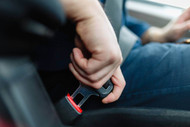Each year, thousands of people die in the United States as a result of automobile-related accidents. Many of these deaths could have been prevented by the use of seat belts. These important, life-saving safety features in cars can help save lives when worn correctly and consistently. While the seat belt laws can vary from one state to another, all laws are put in place specifically to enforce the use of seat belts in order to help prevent serious injury or even the death of automobile drivers and passengers.
History
The first standard safety or seat belt was implemented in most vehicles in 1855. But it was not until 1959 that a better, safer version known as the three-point belt began to become standard, originally put in place by car maker Volvo in Sweden. It became the norm in the United States in 1963. Soon, other car manufacturers followed suit. By the following year, almost all automobile manufacturers were installing a front driver and passenger seat belt in their cars. Shoulder belts were added in 1968 to provide better protection for the upper body from the impacts of an accident. Unfortunately, even with all of these new safety measures in place, many people were still not wearing them. It was not until 1984 that an official seat belt law was enacted in New York, which prompted other states to begin adopting their own laws regarding the use of the device. By 1996, every state except New Hampshire had some kind of law put into place regarding the use of seat belts.
- A History of Seat Belt Development
- Auto Safety History
- Nils Bohlin: Inventor of the Three-Point Safety Belt
- Historical Experience With Seat Belt Use Technologies
- Seat Belts: A Century of Safety
Laws
Wearing a safety belt can often be the difference between life and death, which is why laws have been enacted and enforced throughout the United States. The two main types of seat belt laws are primary and secondary. For states with a primary law in place, people can be pulled over and ticketed if they are not wearing a seat belt, even if they have not violated any other law. For states with secondary laws, the driver can only be penalized for not wearing a seat belt if they've been pulled over for another driving-related offense first. These laws can change frequently depending on each individual state's legal opinion on the effectiveness of using primary versus secondary laws to enforce the use of safety belts. There are also important child restraint laws in place in every state that require parents to properly use child safety seats and belts to keep them secured while riding in a vehicle. Some states also require school buses to use seat belts.
- Primary Enforcement of Seat Belt Laws
- State Seat Belt Laws
- State-by-State Seat Belt Law Breakdown
- How Seat Belt Use Enforcement Saves Lives
- State Laws Requiring Seat Belts in School Buses
Facts
When wearing a seat belt becomes a habit, it's easy to remember to buckle up while riding along in a car or getting behind the wheel. New technology in most modern vehicles includes an alarm that is only silenced once the belt has been fastened. This has greatly reduced the number of driving fatalities since it practically forces the occupants of the car to buckle up. Safety belts should be comfortable yet tight enough to ensure a snug fit in order to hold people inside of the car if an accident were to occur. It is important to be sure the belt is worn properly or else it can cause internal injury. Statistics have shown that seat belts have reduced the number of vehicle fatalities by half. Most deadly crashes occur within 25 miles of home, which is why wearing a seat belt each and every time is extremely important, no matter how far the driving distance.
- Seat Belts: Why You Should Use Them
- Advice on Safety: Seat Belts and Air Bags
- Seat Belts, Air Bags, and Child Passenger Safety
- Staying Safe in the Car and on the Bus
- Driving Tips: Failure to Buckle Up
- Myths and Facts About Seat Belts
- Did You Know? Seat Belt Fast Facts
- Seat Belt Tips for Safe Kids
- The Physics of Seat Belts
- Important Myths and Facts About Seat Belt Use (PDF)
- Seat Belt Safety Fast Facts
- Child and Teen Car Safety
- Buckle Up America
- How Modern Seat Belts Work
- Seat Belts: Lock in the Future (Video)
- Stats: Seat Belt Use
- Five Facts You Didn't Know About Seat Belts
- There's No Excuse Not to Buckle Up
- Injury Prevention: Seat Belts
- It's a Fact: Seat Belts Save Lives
Fun
In order to practice good safety habits, kids and teenagers should be taught about the proper use of seat belts at an early age. Through education and fun activities, children will grow up to be responsible, safe drivers. There are many programs in place that are designed to teach children and teenagers about the importance of buckling up. With the right tools, all kids can learn about proper seat belt use so that they will become safe drivers when they're old enough to get behind the wheel.
- Izzy's Road Safety Game
- Seat Belt Sheriff Quiz
- Vehicle Safety Game
- Game: Eyes on the Road
- Interactive Crash Simulation for Teens
- What are the main purposes of seat belts?
- Seat belts are designed to keep occupants safe by reducing the risk of injury or death during an automobile accident.
- When were seat belts first introduced in vehicles?
- The first standard safety belt was implemented in vehicles in 1855, but the three-point belt became standard in 1959.
- What are the different types of seat belt laws in the United States?
- The two main types are primary laws, allowing tickets for not wearing a seat belt alone, and secondary laws, which penalize non-use only if another violation occurs.
- Why is it important to wear a seat belt at all times?
- Wearing a seat belt significantly reduces the likelihood of fatal injuries in accidents, especially since most crashes occur within 25 miles of home.
- How can parents educate children about seat belt safety?
- Parents can use programs and interactive games that teach kids the importance and proper use of seat belts from an early age.





